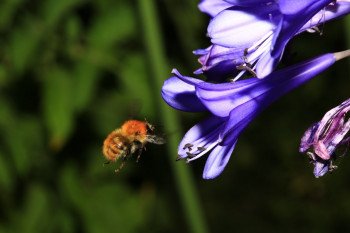News
Bumblebees Reveal a Smart Shortcut for Visual Recognition
Centre for Brain and Behaviour14 April 2025
New research led by Queen Mary University of London uncovers how bees use active scanning to solve visual tasks—offering insights for bio-inspired AI and robotics.
Bumblebees may have tiny brains, but when it comes to visual problem-solving, they punch well above their weight. A new study published in eLife shows that bees use active scanning strategies to distinguish between simple patterns—such as a plus sign "+" and a multiplication sign "×"—by focusing on just one critical part of each shape during flight.
Dr Marie-Geneviève Guiraud, former PhD student at Queen Mary University of London and currently a postdoctoral researcher at Macquarie University in Australia, explains:
"Bees simplify complex visual tasks by controlling how they view the world through their own movement. Surprisingly, they used different scanning behaviours depending on the visual pattern. This efficient strategy enables them to make fast and accurate decisions".
The research, a collaboration between Queen Mary University of London and the University of Sheffield, reveals that bumblebees don't passively observe entire shapes. Using high-speed videography within a carefully designed experimental setup, the team found that bees consistently inspect a specific region—typically the lower left corner—before making a decision. When this region was obscured in follow-up tests, the bees were unable to recognise the correct pattern, confirming their reliance on this targeted scanning routine.
Dr HaDi MaBouDi, lead author and Research Fellow at the University of Sheffield, said:
"The findings support the growing view that intelligence is not merely a function of brain size or processing power, but emerges from the dynamic interplay between brain, body, and environment. By actively shaping their sensory input, bees demonstrate a form of embodied cognition that allows them to solve problems efficiently—a principle with exciting potential for the next generation of adaptive, resource-efficient AI systems".
Professor Lars Chittka, senior author and Professor of Sensory and Behavioural Ecology at Queen Mary University of London, added:
"The notion that there are tight links between action and perception was first expounded by pioneering psychologist Margaret Washburn over a century ago. It is wonderful to see how broadly the principles of active vision apply across the animal queendom, including, now, the insects!".
This study highlights that even insects with small brains can perform complex visual tasks by actively controlling their visual input. The research not only advances our understanding of insect cognition, but also opens new avenues for developing efficient visual processing systems in robotics and artificial intelligence.
Read the full study in eLife
Email: l.chittka@qmul.ac.uk
Updated by: Rani Moran





